Replacing BMW E36 Brake Pads
Hi Guys,
I found this nice article ,which was written by Wayne R. Dempsey, on this page. I thought that many of you guys would like to know how to change these pads. For those who don’t like to use their hands, at least, it’s a nice thing to know how to do it.
I saw that many times being done, but there’s nothing better than doing the work yourself to make sure you learned it, so here you go … enjoy. Please remember to wash your hands after you’re done 🙂
Disclaimer: Use it at your own risk!
Replacing your brake pads is one of the easiest jobs to perform on your BMW. In general, you should inspect your brake pads about every 10,000 miles, and replace them if the material lining of the pad is worn down enough to trigger the pad replacement sensor. In reality, most people don�t inspect their pads very often, and usually wait until they see the little brake warning lamp appear on the dashboard. It’s a wise idea to replace the pads, and inspect your discs as soon as you see that warning lamp.
If you ignore the warning lamp, you may indeed get to the point of metal on metal contact, where the metal backing of the pads may be contacting the brake discs. Using the brakes during this condition will not only give you inadequate braking, but will also begin to wear grooves in your brake discs. Once the discs are grooved, they are damaged, and there is almost no way to repair them. Resurfacing will sometimes work, but often the groove cut will be deeper than is allowed by the BMW specifications. The smart thing to do is to replace your pads right away.
Brake pads should only be replaced in pairs � replace both front pads or both rear pads at a time. The same rule applies to the brake discs that should be checked each time you replace your brake pads.
The procedure for replacing pads on all the wheels is basically the same. There are slight configuration differences between front and rear brakes, but in general the procedure for replacement is similar. The first step is to jack up the car and remove the road wheel. This will expose the brake caliper that presses the pads against the disc

Tip: Make sure that the parking brake is off when you start to work on the pads.
If you look inside the caliper, you will see the brake pads – usually they will look very thin, as is shown here

Begin by removing the small plastic cap that covers the caliper guide bolts

The BMW caliper used on the 3-Series (and many other BMWs) is a single piston caliper design. One piston presses against the side of the brake disc, and the whole caliper slides on the guide bolt to achieve equal pressure on the disc from both pads.
replace the brake pads, you need to remove the caliper. Remove both guide bolts from the
caliper

Then remove the brake pad retaining clip (keeps the pads from rattling)
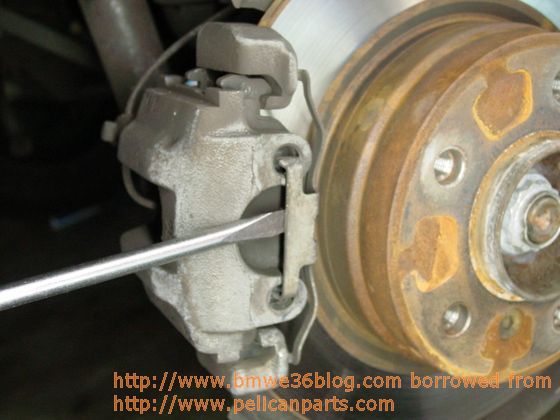
Make sure you wear safety glasses during this step, as the clip can come flying off if you’re not careful. Then, use a pair of needle-nose pliers to remove the brake pad sensor
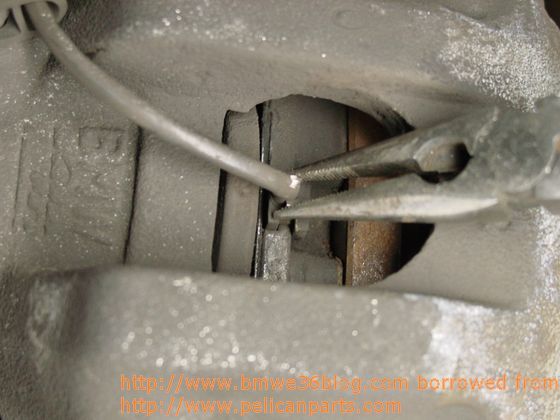
After the guide bolts have been removed, you should be able to simply lift the caliper off of its mount
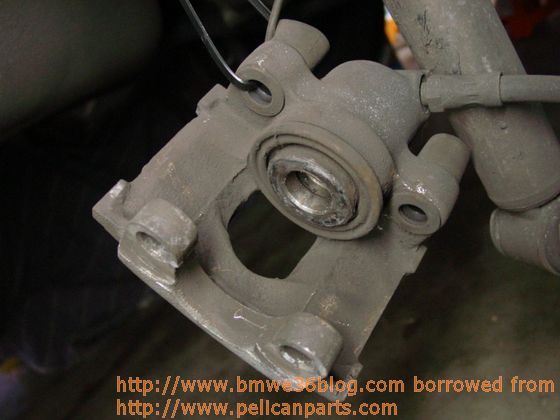
Suspend the caliper using some zip-ties or rope – don’t let the caliper hang from its rubber hose (very bad). See the follow screenshot for details.
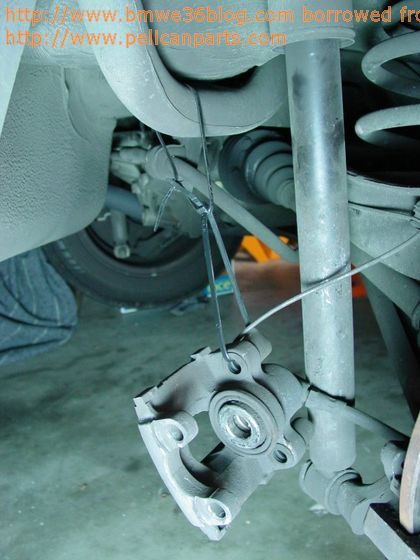
As this point, you can pluck the outer brake pad out of the caliper, and use a screwdriver to pry the inner pad out of the caliper piston. The caliper should resemble this when you’re done.
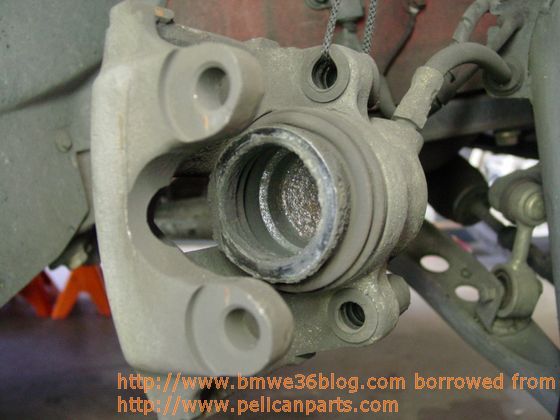
Once you have the pads removed, inspect the inside of the caliper. You should clean this area with some compressed air and isopropyl alcohol. Make sure that the dust boots and the clamping rings inside the caliper are not ripped or damaged. If they are, then the caliper may need to be rebuilt.
At this point, you should inspect the brake discs carefully. Using a micrometer, take a measurement of the disc thickness. If the disc is worn beyond its specifications, then it�s time to replace it along with the one on the other side. See our Pelican Technical Article on Replacing BMW Brake Discs for more information.
The installation of the new brake pads is quite easy. You will need to take a small piece of wood or plastic and push the caliper piston back into the caliper
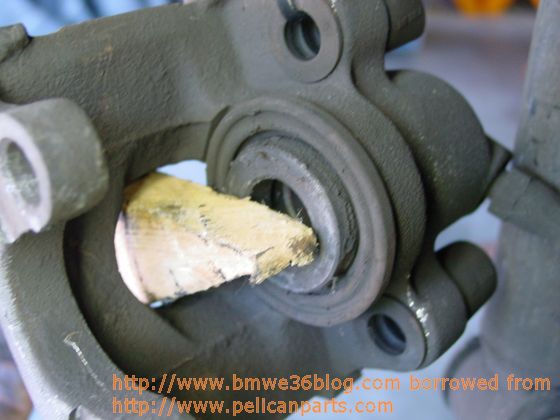
This is because the new pads are going to be quite a bit thicker than the old ones, and the piston is set in the old pad�s position. Pry back the piston using the wood, being careful not to use too much force. Using a screwdriver here can accidentally damage the dust boot and seals inside the caliper, and is not recommended. Be aware that as you push back the pistons in the calipers, you will cause the level of the brake reservoir to rise. Make sure that you don�t have too much fluid in your reservoir. If the level is high, you may have to siphon out a bit from the reservoir to prevent it from overflowing. Also make sure that you have the cap securely fastened to the top of reservoir. Failure to do this may result in brake fluid accidentally getting on your paint.
When the piston is pushed all the way back, you should then be able to insert the new pads
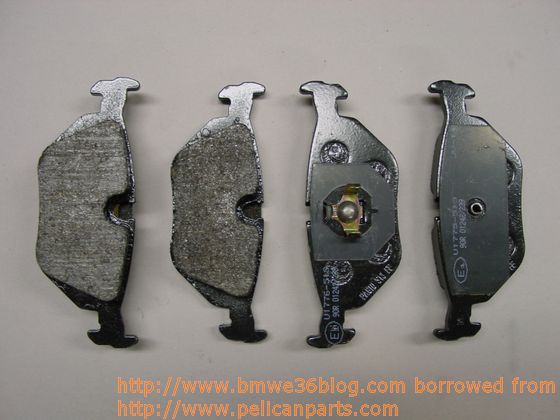
into the caliper. If you encounter resistance, double check to make sure that the inside of the caliper is clean. Simply snap the inner brake pad into place using your hand
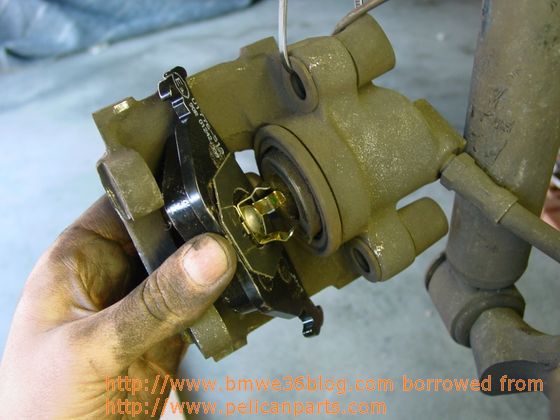
When firmly mounted, the new pad should resemble this
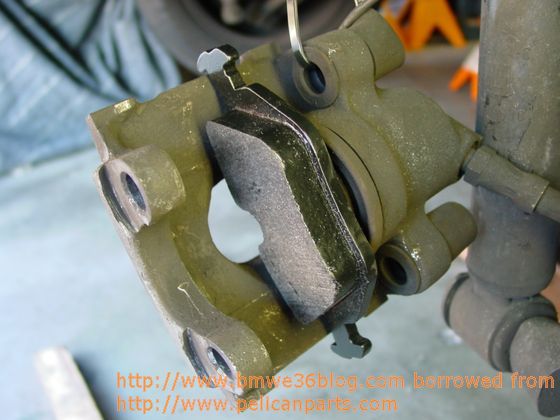
The process for assembly is the reverse of the disassembly. Mount the caliper back onto its mounting bracket, surrounding the brake disc. If the caliper won’t fit, then you need to push in the piston a bit more until the space in-between both pads is wide enough for the brake disc to fit. Tighten down the guide bolt using a torque wrench to 22 ft-lb (30 Nm).
If your brake sensors activated the lamp on your dashboard, they should be replaced with new ones. Disconnect the sensor
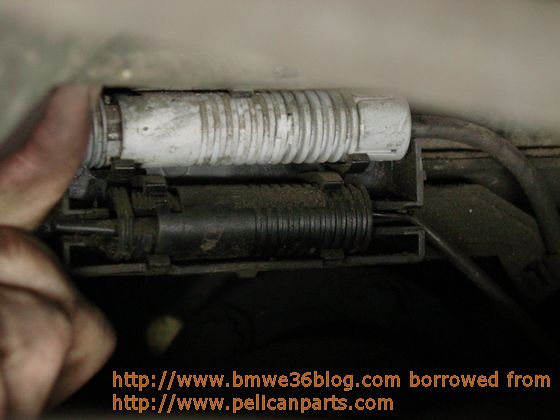
and plug in the new one. Then snap the new sensor into the small gap in the brake pad
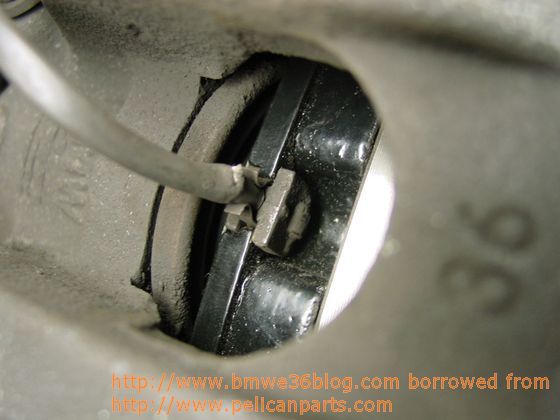
You also may want to spray the back of the brake pads with some anti-squeal glue. This glue basically keeps the pads and the pistons glued together, and prevents noisy vibration. Anti-squeal pads can also be purchased as sheets that are peeled off and placed on the rear of the pads.
When finished with both sides, press on the brake pedal repeatedly to make sure that the pads and the pistons seat properly. Also make sure that you top off the master cylinder brake fluid reservoir if necessary. Brake pads typically take between 100 and 200 miles to completely break in. It�s typical for braking performance to suffer slightly as the pads begin their wear-in period. Make sure that you avoid any heavy braking during this period.
Well, there you have it – it’s really not too difficult at all.
Are you looking for more do it yourself procedures (DIY) ? I recommend the Bentley BMW 3 series service manual for you. I got it and I think it’s a gold mine for us -BMW E36 Owners-. If you didn’t grab your copy yet, get it right now! I’m sure you’ll find this book worth every penny you’ve paid for. Get the Bentley BMW 3 series service manual
Wait for more from BMW E36 Blog
best regards,
Tony Sticks.

Want to receive exciting tips & information about BMW E36 cars? Enter your Email:-
posted in Brakes, Do It Yourself | 11 Comments

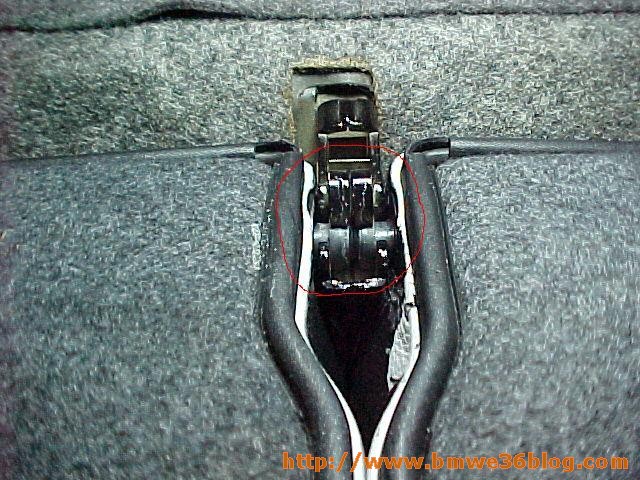
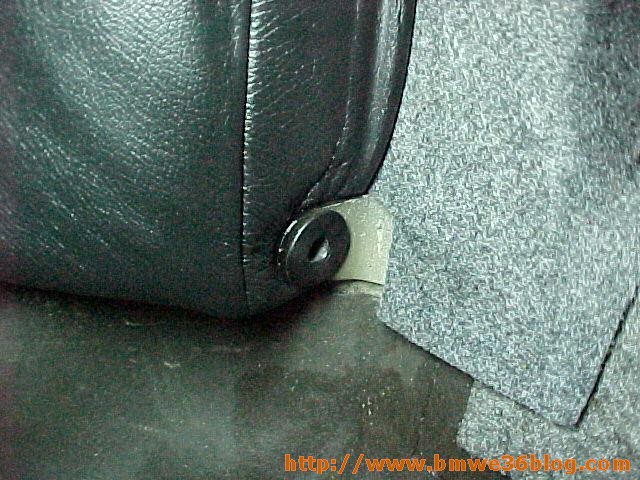
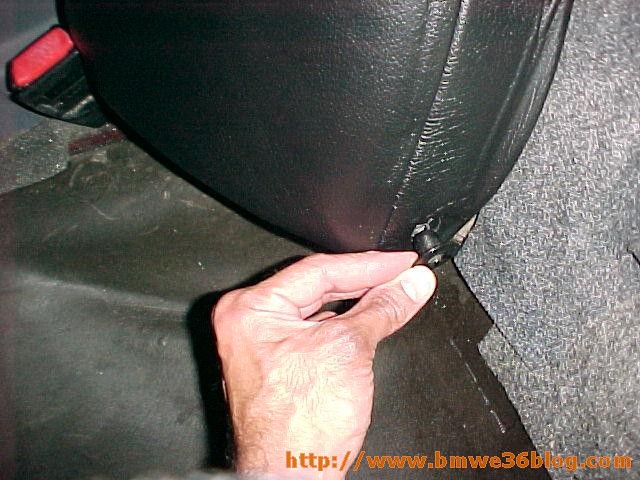
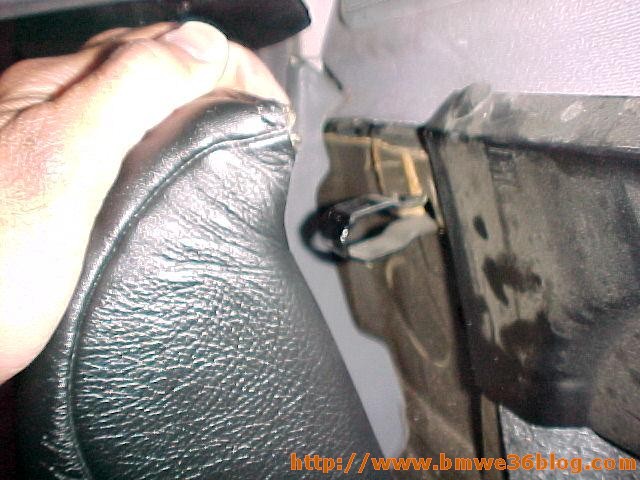
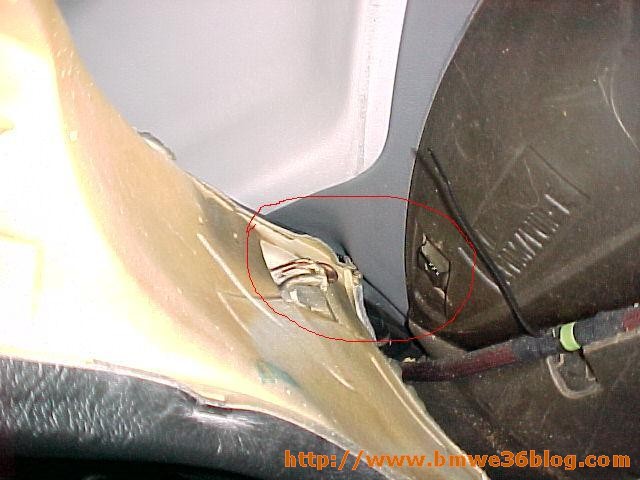










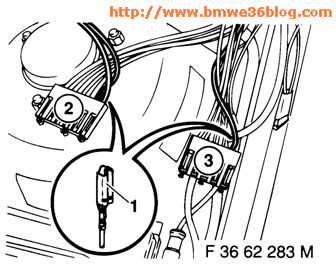
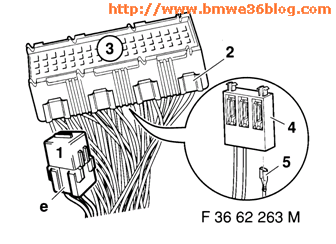
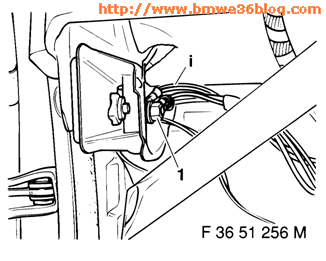
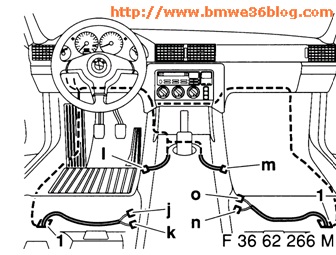
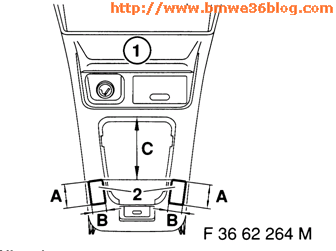
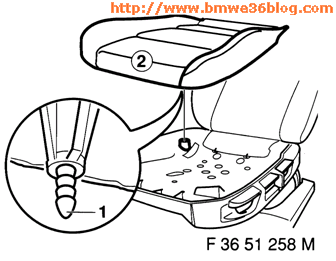
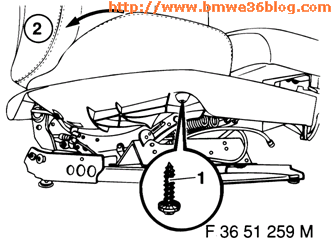
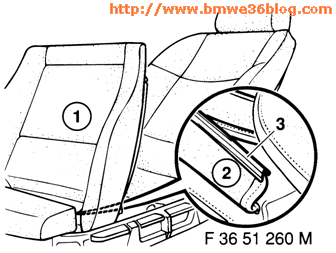
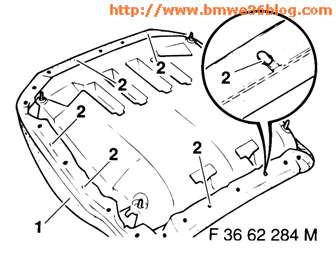
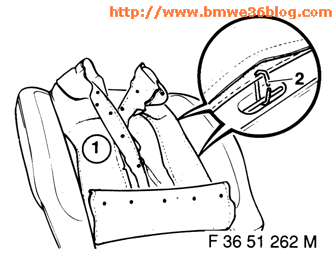
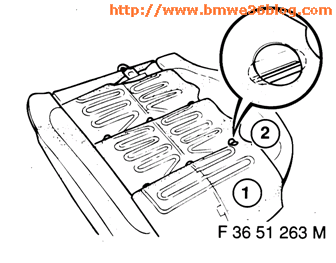
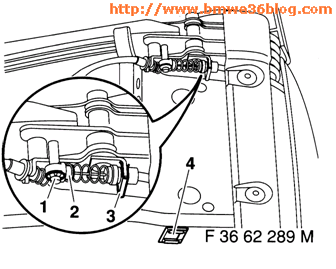
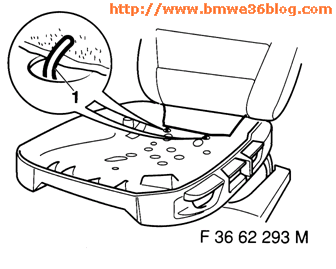
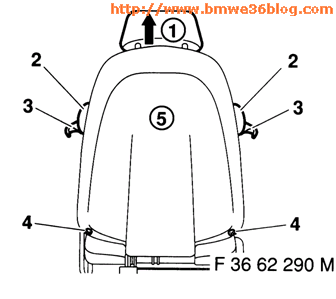
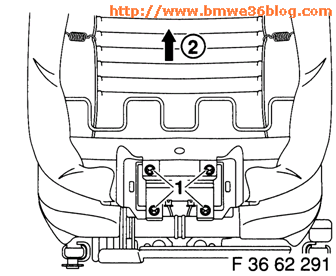
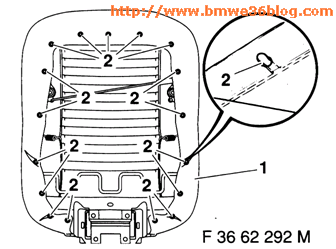
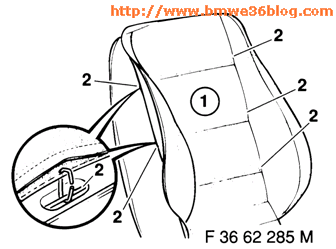
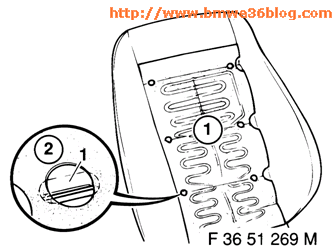
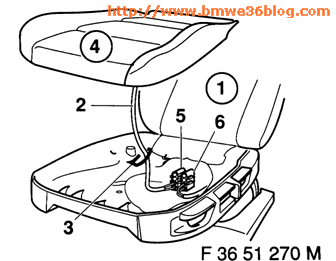
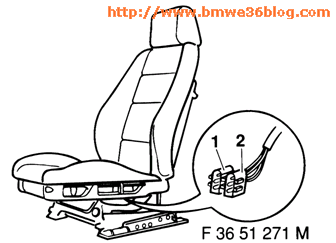

 (4.86 out of 5)
(4.86 out of 5) (4.07 out of 5)
(4.07 out of 5)



